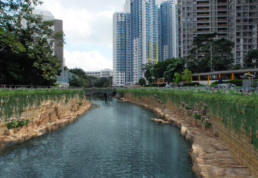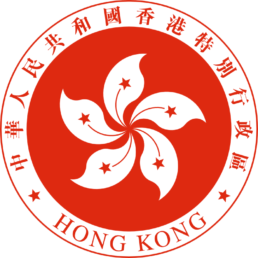Hong Kong is tackling its serious flooding problem by taking a holistic and integrated approach to stormwater management.
To address severe flooding, Hong Kong’s Drainage Services Department implemented a range of projects to improve water drainage in the city. Rather than building drainage facilities in flood-prone areas, the city is intercepting and diverting waterways along their natural courses to better prevent flooding. To date, Hong Kong has created 2,400 km of stormwater drains, 350 km of river channels, and three underground flood storage tanks that hold a total of 17,000 m3. The city’s robust drainage infrastructure not only reduces the risk of flooding, it also revitalizes water bodies and creates green spaces, which in turn promote biodiversity and mitigate the heat island effect.

The city has committed nearly $5 billion to flood-prevention projects and water revitalization projects. Successful examples include the sophisticated Happy Valley Underground Stormwater Storage Scheme, which monitors water retention in underground storage tanks. Similarly, the 3.7-km Lai Chi Kok Drainage Tunnel intercepts runoff from uphill catchment in West Kowloon.
115 tons of CO2 reduced per year through planting trees and installing green roofs
The challenge
Hong Kong averages more than 2,300 mm of rainfall each year, one of the highest rates in the Pacific Rim, and storms are expected to become more common in coming years. Its dense population and mountainous terrain exacerbate the challenges of flooding. This wide-ranging, integrated approach to flood management helps the city maintain its economic growth without sacrificing sustainability or safety.
Co-benefits
Economic Property values have risen by up to 10% in areas that have experienced water revitalization.
Environmental Photovoltaic panels installed at Hong Kong’s water treatment facilities will generate 828,000 kWh of electricity by 2017.
Social The 144 km of revitalized waterways provide residents with more enjoyable places to walk and cycle, thus promoting more outdoor urban activities.
About Hong Kong
Hong Kong is an autonomous territory on China’s south coast. It has an area of 1,104 km2, and with a population of around 7.2 million, Hong Kong is the world’s fourth most densely populated country or territory. Hong Kong is one of the world’s most significant financial centres, with the highest Financial Development Index score and consistently ranks as the world’s most competitive and freest economic entity. Nicknamed “Pearl of the Orient”, Hong Kong is renowned for its deep natural harbour, which boosts the world’s 5th busiest port and its impressive skyline, with the most skyscrapers in the world.


